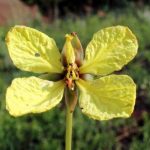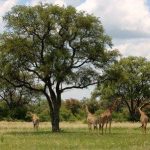TREE LIFE
April 2004
MASHONALAND CALENDAR
APRIL. Annual subs are now due. Prompt payment would be appreciated. $5000 for Tree Life by email or $10000 by post
Tuesday 6th April. Botanic Garden Walk. Meet Tom in the car park at 4.45 for 5 p.m. for a walk of general interest.
Sunday 18th April. For a day trip (or spend the weekend) to Mazvikadei Dam near Banket. There is accommodation available for a few members to spend the weekend. Please contact Maureen if you wish to reserve a space, and for other details. It will be self catering.
For the Sunday’s outing we will meet at No. 139 at 9.30 a.m. Bring lunch and plenty of water.
Sunday 25th April. There will be a special tree planting ceremony in memory of Lyn Mullin in the grounds of The Forestry Commission, Orange Grove Drive in Highlands.
The ceremony starts at 2.30pm after which tea will be served. Everyone will be very welcome, and it will be possible to purchase a copy of Lyn’s beautiful book Historic Trees of Zimbabwe
Saturday 1st May. Observe May Day with Tom Muller when he leads the first of the winter time walks this Saturday morning.
NOTICE OF ANNUAL GENERAL MEETING
Notice is hereby given that the 54th Annual General Meeting of the Tree Society of Zimbabwe will be held at Thetford Estate, Christon Bank on a date to be advised.
Any proposals/resolutions and nominations for office bearers should be forwarded to P O Box 2128, Harare by Monday 3rd May if possible, although proposals and nominations will be accepted from the floor.
AGENDA
1.Notice convening the meeting.
2. Apologies.
3. Minutes of the 53rd A.G.M.
4. Matters Arising.
5 Chairman’s Report.
6. Treasurer’s Report.
7.Election of Committee Members.
8. Any Other Business.
MATABELELAND CALENDAR
Nothing has been arranged for April.
BOTANIC GARDEN WALK: 6 JANUARY 2004
Tom’s subject for today was the Annonaceae. This is a small, but interesting, family in Zimbabwe consisting mainly of woody plants.
What are the features of the family? Ours are trees, shrubs or woody climbers (sometimes very large lianes as in Artabotrys); rarely they can be a suffrutex with stems that die back each year, as in Annona stenophylla subsp. nana.
The leaves have a number of distinguishing features. Firstly they are alternate, with an angle of divergence of 180. On other words, they form a flat plane. In addition, crushing the leaves usually produces an aroma a gentle medicinal smell. Furthermore, the leaves are entire and there are no stipules.
Confusion is possible with certain Euphorbiaceae which can also have alternate leaves in a plane, but there is never the smell in the crushed leaf and stipules are present in the Euphorbiaceae (but may fall off quickly).
The flowering parts are usually in multiples of 3: i.e. 3 sepals and usually 6 petals. The stamens are numerous. The fruits consist usually of several free elongated lobes think for example of Friesodielsia but in some species these are solidly fused together to make one apparent fruit (Monodora).
Firstly, the genus Xylopia was looked at. There are three species in Zimbabwe: two are forest species: aethiopica and parviflora (formerly holstii) occurring only in the eastern districts and the other one, X. odoratissima, is a plant of the Kalahari sand in the NW.
- aethiopica is an extremely tall forest tree. Tom reported that he was able to find seed of this species by following the scent. As was to be expected the leaves were arranged in one plane and, typical of forest trees, had long drip tips. X. parviflora is a tree of drier forests than aethiopica. Typically it has branches arranged horizontally; it is in fact a deciduous tree, but its leaf change is very fast. X. odoratissima is a lovely little tree occurring in Kalahari sand.
A small genus is Monanthotaxis with two species. Monanthotaxis chasei is a climber with very glaucous leaves beneath. The leaves are also obovate and again are aromatic when crushed. The species is quite widespread in medium and low altitude forests. Monanthotaxis buchananii is a very rare species in Zimbabwe and has been found only once, in the Burma Valley.
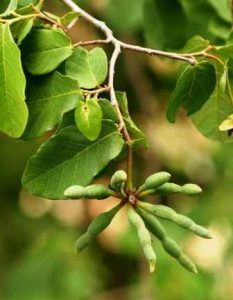
Friesodielsia obovata. Photo: Bart Wursten. Source: Flora of Zimbabwe
After these rare trees we don’t often see, it was a pleasure to look at two we do. Friesodielsia obovata was in full flower, showing off its parts in threes. Tom remarked that this was one of the nicest wild fruits to eat.
Hexalobus monopetalus also has edible fruits. Although a lowveld species it does attain higher altitudes and we see it quite often around the Harare area.
Cleistochlamys kirkii is a component of the jesse in the Zambezi Valley. It grows on sandstone hillsides in areas where the soil is a bit deeper. Again this had annonaceous characteristics: leaves aromatic, in one plane and with no stipules.
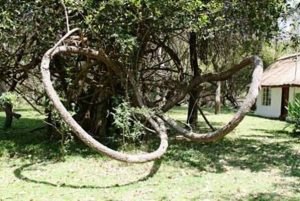
Artabotrys brachypetalus. Photo: Mark Hyde. Source: Flora of Zimbabwe
Then on to two species of Artabotrys. Artabotrys brachypetalus is a powerful climber, typically scrambling in the vegetation by lowveld rivers. The fruits are a striking blackish-blue. The plant itself bears remarkable hooks which are strangely angled are really persistent flower peduncles.
Artabotrys monteiroae is a similar plant, bearing similar hooks, but occurs in the eastern districts in low to medium altitude forest.
The last native species seen was the extraordinary Monodora junodii. It was the wrong time of year to see the strange blackish-purple flowers, but we had seen them on the walk in November. The fruits are simple, more or less spherical and have a hard coat; the faint presence of 6 sides to the fruit suggesting that it was composed of fused parts in threes.
Finally we stopped in the cultivated plants section and looked at Annona muricata from the W. Indies. This has various names: graviola, prickly custard-apple. This has thickly 3-lobed flowers which appear on the old wood and also extraordinary prickly fruits.
Once again, it was a fascinating evening and I would like to thank Tom for his time and trouble.
-Mark Hyde
DOMBOSHAWA: 15 FEBRUARY 2004
Domboshawa is one of my favourite places. Tree Society outings take us there on average twice a year and it is a source of never-failing botanical interest. Even in mid-winter when the vegetation retreats into shades of grey and brown and the seepage zones dry up, plants are still to be found and it has a strange beauty.
At this time of year, in February with the rainy season under way and the seepage zones running with water, it is absolutely at its best.
The first tree of interest was a common one, namely the mahobohobo, Uapaca kirkiana. The trees in the car park were spectacularly in flower; I’ve never seem them look so striking with a broad cuff of flowers on the wood below the apical tuft of leaves. As with all Euphorbiaceae, the flowers were unisexual and it was very easy, as the flowers are quite large, to detect which were male and which female.
I had thought that the Uapaca was dioecious, that is with male and female flowers on separate trees, so that some trees produce fruit and others do not at all. However, at least one tree clearly had a mixture of both male and female flowers in different parts of the same tree. The position is obviously more complex than I had thought.
We paid our entrance fee and headed up the rocks looking at the plants which make Domboshawa so distinctive. Everywhere were the wiry tufts of Coleochloa setifera (Cyperaceae), a grass-like sedge whose leaves on top of bare rock can create a slippery effect. Also very common is the finger-staining shrub, Plectranthus sanguineus.
Everywhere in the wetter places was the golden-yellow heads of Emilia brachycephala, a rather local plant generally, but here quite common. Also, the trailing stems and pretty small white flowers of Cyphia reducta, another common plant at Domboshawa. Cyphia is related to Lobelia; it has the same asymmetric flowers, but cyphias trail or climb whereas our lobelias do not.
We headed upwards and over to the right, round the hill about a quarter of the way. Another striking herb was Pentas nobilis which has exceptionally long white corollas. This is a Rubiaceae and has leaves opposite or in whorls with the usual stipules typical of the family. Trees were a bit limited in this open rocky environment but we did see Hymenodictyon floribundum (the Fire bush) quite common and came across a fine specimen of the Granite Garcinia, Garcinia buchananii.
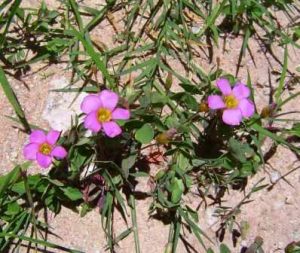
Oxalis obliquifolia. Photo: Bart Wursten. Source: Flora of Zimbabwe
As we rounded a corner on a contour, we came across the single flowers of the very pretty Oxalis obliquifolia. There was also a solitary Sterculia quinqueloba in a typical rocky habitat, displaying its large leaves.
Eventually we headed up the slope towards the summit and stopped to explore a patch of vegetation. Here there was a good quantity of bracken (Pteridium aquilinum), which is quite common at Domboshawa as well as Syzygium guineense subsp. afromontanum, which is the more Eastern districts subspecies with darker green leaves and a longer drip-tip. Also present was Olinia vanguerioides, another higher rainfall species.
From this point on, up to the beacon, we were mostly in lichen country and flowering plants were notably absent. I took a picture of the group on the summit and we then headed downwards towards the main cave.
Finally, on the way back down, we stopped at some large granite boulders and looked at the colonies of Streptocarpus pumilus in the shade of the rocks. These were in full flower and are very attractive in their quiet unassuming way.
Once again, it was an interesting visit to Domboshawa. We look forward to many more of them.
-Mark Hyde
PALMS Extracted from and acknowledged with thanks to the magazine of the Albany Museum. R.S.A.
The Phoenix April 1994. Vol 7.No 1.
Phoenix the Date Palm genus. By Estell Brink
The perception that Carl von Linn gave names to all the known plant species when he published his Species Plantarum in 1753 is quite erroneous. What he did was to devise a system of botanical order which grouped like plants together into families, genera and species and most of the time he simply applied the names that had already been in current use within this framework. No one knew better than Linnaeus the luminous quality of words, especially of names, and even when plants were so ‘new’ that no published descriptions existed he searched for a vernacular name to Latinize into his formal system.
But for Phoenix there was no such need for here indeed was a word as old as the language of the ancient Greeks that actually meant palm-tree. For the Greeks the word also had the connotation of red as in the rising sun which, from their vantage point, came to be applied to the country that called itself Canaan which lay to the east of Greece.
The Phoenicians
Canaan extended along the eastern seaboard of the Mediterranean from the mountains of Amanus to Mount Carmel in the south. Bounded inland by the mountains of Lebanon, it was a dry and rocky country not fit for agriculture but blessed with date palms and great forests of cedars. Before them lay the blue expanse of the Mediterranean and it takes no great leap of imagination to realise that the innovative and gifted Semitic race who lived there had no choice but to apply their skills to boat-building and trading. Their initial stock in trade could have been little more than timber, dates and the dye they extracted, drop by precious royal purple drop, from the small murex shell-fish on their coast. They were the first to sail out of sight of land into every part of the Mediterranean and even out into the Atlantic to Gaul and Britain to obtain metals for their craftsmen. With iron and tin from these countries, gold and silver from Spain, copper from Cyprus, pearls from the East, perfumes and spices from Arabia, fine linen from Egypt and lion and leopard skins from Africa, they expanded their trade. And where they dropped anchor along the European and North African coasts and on the many Mediterranean islands, they established trading posts building up a colonial empire which included Cyprus, Malta, Sicily, Sardinia, Marseilles, Spain and later Carthage.
The downfall and disappearance in 1400 BC of the mysterious Minoans who were their only real competitors on the open seas left the Phoenicians in control of the waves and they were able to take a place alongside the great civilisations of Egypt and Mesopotamia. Their cities, Tyre and Sidon, Tripolis and Byblos dominated the development of Western civilisation as we know it for the next millenium. Even after the great island fortress of Tyre fell to the Assyrians in 666 BC this was not the end of the Phoenicians. They retreated to their city state of Carthage in North Africa and for the next five centuries their skill and ability as shipwrights and sailors was sought after by one foreign power after another. It is even possible that these master mariners circumnavigated Africa 2000 years before Diaz and da Gama. Pharoah Necho II sent a Phoenician fleet to find a route around Africa in 600 BC. Whether they succeeded or not is still a matter of debate as no contemporary documents have yet been found to provide uncontrovertable evidence.
Most of our information about the Phoenicians is at second hand either through the Bible or various Greek and Roman historians but there is no doubt that they exerted a strong influence on the Mediterranean cultures. From them the Greeks learnt the arts of sculpture and working in metals. Their alphabet of 22 letters has become the basis for our depiction of speech and the use of metal coins as legal tender in trading became generally accepted.
The Resurrection Bird
The Date Palm had an influence on the imagination too. The story of the resurrection bird, the phoenix, was first retold by Herodotus in 430BC. He had been shown illustrations of it when he visited the City of the Sun (Heliopolis) in Egypt and as it was often pictured nesting in the top of a palm he used the name of the tree, phoenix for the bird as well.
The myth is one that threads its way through both Eastern and Western mythologies. In the far East the myth of the feng-hwang closely parallels that of the phoenix although the Eastern myth tells of a pair of birds. According to Herodotus the phoenix was the only one of its kind and lived in Arabia. About the size of an eagle with dazzling plumage of purple and gold or red, gold and blue it had a life-span of about 500 years. When it felt its end drawing near it built a pyre of sweet spices on which it sat singing a song of rare beauty. Then the rays of the sun ignited this next and consumed the bird in flames. From the ashes a worm would arise which developed into the new phoenix. Its first task was to take its parent’s ashes wrapped in a ball of myrrh and fly to Heliopolis on the Nile accompanied by a throng of birds. There the priests of the Temple of the Sun received the remains with great ceremony. The old phoenix was buried in the temple before the new phoenix returned to Arabia to repeat the cycle of life, death and resurrection. It had the reputation of being a bird of good omen and many a ruler and politician capitalised on the myth to persuade the populace that they were indeed the elect of the gods.
Every myth has a grain of reality or truth. Lost in the mists of time there was surely a real, shy, lonely, vegetarian raptor on the verge of extinction even before the rise of the Egyptian Empire which nested in the date palms just as today we still have Gypohierax, the palm-nut vulture, which nests in the raffia and oil palms of Zululand and East Africa.
A pivot of culture
The plant genus Phoenix consists of 10 – 12 species and all of them originate in the Old World Asia, Arabia and Africa. Classically graceful and easy to cultivate, they have been planted in gardens worldwide or cultivated in plantations for their fruit. The species hybridize easily and this has caused a proliferation of horticultural names for the many different forms and varieties that have arisen in this way.
Phoenix dactylifera, the date palm, occurs naturally in the valleys of the Tigris and Euphrates in Arabia and along the Nile but has also been actively cultivated by the Arabs living in these regions for well over 5000 years. The vital life-support its sweet nutritional fruits afforded the nomadic tribes of these arid semi-desert countries, played a determining role in the formation of settlements which eventually became the great cities and centres of civilisation of the ancient world. The Western style civilisation which dominates world order today traces its origins to these lands. Its laws and concepts of civic order, its philosophies of right and wrong, good and evil are based on the writings of the ancient Hebrews, Persians and Phoenicians whose strong influence on the Greek and Roman civilisations which followed cannot be underestimated and the whole course of human development would have taken a different direction had it not been for the centripetal force exerted by those early groves of date palms on wandering bands of shepherds and goatherds. The deep shade cast by their thick canopies provided relief from the relentless sun not only to people but also to other plants and it was at their feet that man’s early attempts at agriculture were successful.
Like the rest of the genus, the flowers of Phoenix dactylifera are unisexual and are borne on separate male and female plants. In the wild state they rely on wind for pollination and the copious pollen is carried for long distances. In cultivation, good husbandry takes over from the wind and it is the usual practice to tie parts of male inflorescences to the female inflorescences to ensure pollination and a good crop. Only one male plant is needed for every 50 female plants. In the many Middle Eastern wars in history, the destruction of the male plants of the date plantations ranked with rape and the pillaging of villages as one of the most vindictive and barbaric acts perpetrated by the victors over the vanquished. The immediacy and horror of Operation Desert Storm, fresh in everyone’s memory as the first war fought live in our living rooms on television, probably did more damage to the world’s date basket (already in the 1950’s Iraq was supplying more than 75% of the world’s needs) than all these ancient wars put together.
Date trees start bearing fruit in their third year and reach their prime at 30 years. They live to a great age and are productive for up to two centuries. Each tree bears about 100kg of dates per annum in 8 – 10 bunches of fruits. The yields can in some cases be a s high as 200kg per tree. Export dates are harvested from the top of the tree while the lower branches provide for local consumption and are usually eaten in the soft fresh state. Dates for export are either completely sun-dried and can keep indefinitely, or semi-dried and packed loosely in boxes where they keep without fermenting. The percentage of sugar in the dry dates is much higher than in the fresh ripe fruit. The millions of hectares of date trees grown along the rivers of Middle eastern countries still supply most of the world’s dates and the most sought after variety is the Deglet Noor. On a smaller scale, date plantations have been successfully cultivated in southern Australia, California, Mexico and on the banks of the Orange River in South Africa.
Date palm leaves are usually grey-green and fairly stiff and the trees grow to 30 – 40m in height. In their native countries the wood is used to build huts and houses. Fibre from the base of the leaves is used for making ropes and baskets and, mixed with camelhair, is woven into cloth which is used for caravan tents.
Of all the species of Phoenix only the date palm produces such good fruit. The wild date of India, Phoenix sylvestris, is cultivated chiefly for its sap which yields sugar and toddy or palm wine. The trees are tapped from the time they attain about 4ft in height. A notch is made near the top of the stem and each tree yields 70 to 80 litres of sap per annum for the next 20 to 25 years. In this way each tree can produce about four kilograms of sugar per annum and thousands of tonnes of date sugar is produced annually in Bengal alone.
Most familiar of all the palm in South Africa is Phoenix reclinata which occurs as far south as the Kariega river. Its distribution is widespread and it occurs all the way up the eastern coast of Africa to Egypt. The fruits are much smaller than those of the true date palm and are sparsely covered by pulp but are not unlike the true dates in flavour. They are relished by monkeys which have played a major part in their distribution. Steeped in water, the sweet fruits are often used to make a refreshing drink. The plants with their bright green, flexuous, curved leaves make decorative garden subjects and have been cultivated all over the world especially in gardens in the USA.
Phoenix canariensis is probably the most favoured horticulturally of all the species. The trees are very tall, elegant and single-stemmed and make excellent feature plants in lawns or in avenues along street verges. They have dense crowns of light green curving leaves and the species is one of the fastest growers in Phoenix.
The Chinese Dwarf Phoenix, Phoenix roebelenii, grows less than 1m high and the leaves measure about 30cm in length. It is a dainty little palm best suited to semi-shady spots in the garden and is regarded as the most graceful of the small palms used in indoor decoration.
This then is Phoenix, prince of palm genera which has given its name to a nation and to a universal myth. Multi-facetted in its interaction with the tribes of mankind, an integral part of the chain of history, with a multitude of uses from food and drink, clothing and shelter to purest aesthetic beauty.
BOTANIC GARDEN WALK: 3 FEBRUARY 2004
Slightly unusually, two families, namely the Verbenaceae and the Lamiaceae (Labiatae), were on the agenda at the Botanic Garden walk. In the traditional delimitation of these families, the Verbenaceae had most of the woody plants whereas Lamiaceae was a family of mainly herbs. Fairly recent taxonomic changes have resulted in some dramatic transfers from Verbenaceae to Lamiaceae with the following genera moving: Clerodendrum, Karomia, Premna and Vitex.
At the same time, a number of clerodendrums have been split off into an unfamiliar-named genus Rotheca and in other cases their taxonomic rank has changed (what was once a species has become a subspecies etc.).
This leaves Verbenaceae with very few woody plants and those mostly shrubs, namely: Duranta, Lantana and Lippia.
Both families have leaves which are opposite or whorled (there are very few exceptions), mostly simple (but of course Vitex has palmate leaves). The flowers have petals fused in a tube and are usually asymmetric, frequently being 2-lipped with the lower lip prominent. Stamens number 2 or 4. The ovary is superior and the fruit may be a drupe or consist of 2-4 nutlets.
Our first species was Karomia tettensis, a species of the jesse. Older members will probably know it as Holmskioldia tettensis. This species has leaves which are obovate and also deeply serrate with the serrations largest and most irregular in shape near to the leaf apex. The leaves have a slight smell when crushed – not strong but somewhat unpleasant. The young branchlets are typically lenticellate.
Perhaps the plant’s most distinctive feature are the conical “chinese-hat”-like bracts which enclose the flowers.
On next to the genus Tetradenia. The commonest species is Tetradenia riparia (formerly Iboza riparia) which has thick, opposite and decussate leaves with prominent rounded teeth. It is a well-known species, usually occurring in rocky places and flowering in the winter.
A rarer species is Tetradenia brevispicata. I have never seen this. Tom commented that this is a very striking and easily recognisable species. He has seen it at Ngezi siding. In addition to this there is a “species no. 1” which was recorded from the Botanical Garden extension and a further species in the Eastern districts.
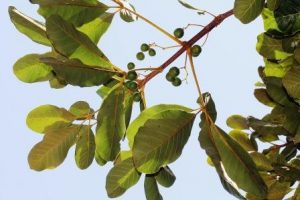
Vitex doniana. Photo: Bart Wursten. Source: Flora of Zimbabwe
On to the genus Vitex and specifically Vitex doniana. This is a tree with large smooth palmate leaves with 5 leaflets. It makes a beautiful shade tree and Tom remembers camping under one in 1967 on Gorongosa Mountain with Hiram Wild and Blake Goldsmith. The leaves were rather high up and difficult to reach but despite Tom’s exhortations, none of the Tree Society ladies were willing to risk the climb. Regular attenders will know that Tom believes that the Tree Society always asks its female members to do the difficult climbs. In Zimbabwe it is a plant of low altitudes in the Eastern Highlands. Tom also remarked that it is probably the biggest species of Vitex.
Vitex ferruginea (formerly V. amboniensis) is a very rare vitex indeed, which Tom has only definitely seen on the Nyoni Mountain. It has delicate leaves and occurs in higher rainfall outliers. Tom thinks he may also have seen it to the south of the Zimbabwe ruins (also another outlier) where it occurred as an understorey in high rainfall Brachystegia woodland.
Vitex payos is of course a very familiar species which we see frequently around Harare. Again, the fruit are edible (tasting of chocolate?), it has 3-5 leaflets and a distinctive bark with very fine fissures. The habitat is usually rocky places.
Vitex schliebenii (for a long time this was known as sp. no. 2) has attractive white flowers which were out on this date. It has edible fruits and occurs in E Africa and in the Chirinda Forest.
Clerodendrum eriophyllum (hairy leaves) is the name we are now using for Clerodendrum glabrum. As it is usually hairy, eriophyllum is a better name. This has a strong, unpleasant smell and opposite or whorled leaves. It’s habitat shows wide variation Tom commented it was not typical of any association.
In the same forest section as the Vitex doniana, we came across the spiny stems of Clerodendrum cephalanthum subsp. swynnertonii, formerly called Clerodendrum swynnertonii, one of those changes of rank referred to earlier. The spines are the hardened leaf petioles and these act to support the plant. Crushing the leaves produced a faint odour, nothing much compared to the strongly stinking nature of the common ones around Harare.
As an aside, it is interesting that the leaves of the commonly-planted exotic species of Clerodendrum thomsoniae has no smell at all, so it appears that it is not a characteristic of the genus worldwide, as it seems to be in Zimbabwe.
Out of Clerodendrum has come Rotheca and we saw two species of this new genus. Rotheca myricoides and R. wildii. R. wildii has larger leaves which are hairless and often highly fleshy, almost succulent. It occurs in woodland rocky places. R. myricoides has hairy leaves.
-Mark Hyde
MARK HYDE CHAIRMAN


